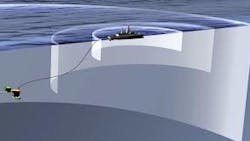Lockheed Martin to build and refurbish towed-array sonar systems for Navy surface warships and submarines
SAN DIEGO – U.S. Navy anti-submarine warfare (ASW) experts are asking Lockheed Martin Corp. to build and refurbish towed-array sonar systems to detect and pinpoint enemy submarines in a contract potentially worth more than a quarter billion dollars.
Officials of the Naval Information Warfare Systems Command (NAVWARSYSCOM) in San Diego announced a potential $286.8 million contract Friday to the Lockheed Martin Rotary and Mission Systems segment in Liverpool, N.Y., for towed-array sonar work.
The contract, initially worth $16.4 million, is to build new towed arrays, as well as repair and refurbish existing towed arrays. It includes spare parts, engineering services and support.
Lockheed Martin builds several kinds of towed-array sonar systems for surface warships and submarines, including the TL-29A twin-line towed array; TB-29A submarine towed array; the TB-37/U multi-function towed array (MFTA), the TB-29X submarine towed array, and the TB-34 submarine towed array.
The twin-line 29A array (TL-29A) is a passive, low-frequency sensor system towed by the T-AGOS surveillance ship. Each array comprises a chain of acoustic, telemetry, and interface modules linked together in an integrated system.
The TL-29A's passive acoustic and signal-processing technologies can hear submarines at long range and in various sea states. The towed-array sonar is designed particularly to detect and track the new generation of extremely quiet diesel electric submarines operated by foreign navies.
The TL-29A sonar is configured as a pair of mile-long arrays that are towed side-by-side from an electro-optic tow cable attached to a winch on the deck of the host surface ship.
As a passive sensor, TL-29A does not generate a signal but uses sensitive hydrophones to listen for the faint sounds emitted by extremely quiet diesel electric submarines.
Related: Navy asks Lockheed Martin to build towed-array sonar systems for Navy surface warships
The TL-29A, along with its submarine-mounted cousin, the TB-29A, uses an advanced telemetry called towed array integrated product team (TAIPT). The TAIPT is a commercial off-the-shelf (COTS)-based telemetry architecture.
TB-29A Compact Towed Array (CTA) towed-array sonar is for Navy Virginia-class fast-attack submarines. It represents the next generation of sonar array technology, and incorporates CTA telemetry while maintaining TB-29A acoustic performance.
The TB-37U is part of the AN/SQQ-89(V) undersea warfare and anti-submarine warfare combat system. It is a next-generation passive and active sonar receiver configured as a long 3-inch-diameter array that can be towed behind surface warships. It is for Arleigh Burke-class destroyers, Ticonderoga-class cruisers, Independence- and Freedom-class littoral combat ships, and Zumwalt-class land-attack destroyers.
The TB-37U MFTA is an active and passive sonar. It can remain silent and simply listen for the sounds of enemy submarines, or it can ping active to bounce sound off the hulls of submarines in the area.
The TB-29X is a 416 channel thin line towed array with an equivalent acoustic performance capability to TB-29A. The TB-29X is a thin line towed array passive sonar receiver that has the same form factor as the TB-29 array, yet offers increased capability, greater reliability and reduced obsolescence.
Towed array sonar uses hydrophones towed on a cable trailing behind a submarine or a surface ship; it can be miles long. It's designed to keep the array's sensors away from tow vessel noise to improve its signal-to-noise ratio and its ability to detect and track faint contacts like quiet nuclear- and diesel-powered submarines and seismic signals.
The TB-34 was developed to provide improved anti-submarine warfare and contact-avoidance capability for submarines operating in cluttered littoral environments. It is one of several acoustic sensors that provide data to the Acoustics-Rapid Commercial Off-the-Shelf Insertion (A-RCI) sonar system installed on U.S. fast-attack, ballistic missile, and cruise missile submarines.
This contract includes options which, if exercised, would bring the cumulative value of this contract to an estimated $286.8 million. Lockheed Martin will do the work in Liverpool, N.Y., and will be finished by February 2025.
For more information contact Lockheed Martin Rotary and Mission Systems online at www.lockheedmartin.com, or the Naval Information Warfare Systems Command at www.public.navy.mil/navwar.
About the Author
John Keller
Editor-in-Chief
John Keller is the Editor-in-Chief, Military & Aerospace Electronics Magazine--provides extensive coverage and analysis of enabling electronics and optoelectronic technologies in military, space and commercial aviation applications. John has been a member of the Military & Aerospace Electronics staff since 1989 and chief editor since 1995.
